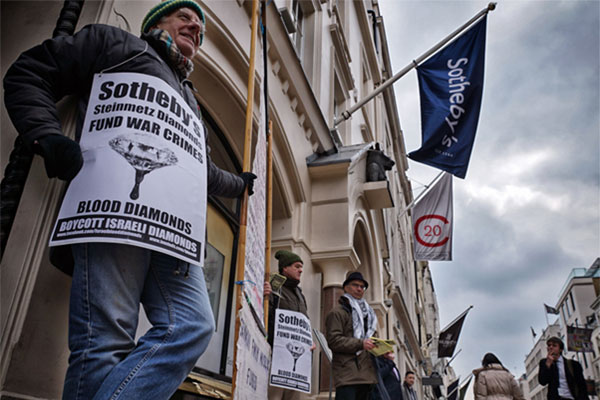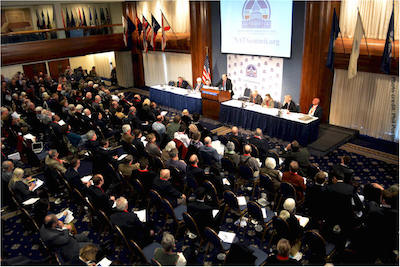$83-million diamond default: Sotheby’s and Israeli war crimes
Apr 8 2014 / 5:41 pm
By Sean Clinton.
Middle East Monitor – Last November, amid a fanfare of international publicity, Sotheby’s achieved a world record $83 million for a pink diamond auctioned in Geneva. Four months later, on February 27, Sotheby’s disclosed that they were forced to take the diamond, they then valued at $73 million, into their inventory when the consortium of investors led by Isaac Wolf, a New York diamond cutter, defaulted.
There is a lot about this story that doesn’t add up; key questions remain unanswered leading to the suspicion of a cover-up.
A brief, but significant new “Risk Factor” included in Sotheby’s Form 10-K Annual Report on February 27, 2014, may offer a clue to this turn of events. It warns: “Sotheby’s could be exposed to reputational harm as a result of wrongful actions by certain third parties. Sotheby’s is involved in various business arrangements and ventures with unaffiliated third parties. Wrongful actions by such parties could harm Sotheby’s brand and reputation.”
Sotheby’s has not explained why they felt it necessary to include this previously unreported risk factor.
According to numerous media reports Sotheby’s claimed the buyer of the pink diamond “couldn’t pay and defaulted”. Isaac Wolf has not given any interviews or responded publicly since the news broke at the end of February.
When asked by JCK magazine why the diamond wasn’t sold to one of three under bidders, Sotheby’s “declined to comment”.
It is difficult to believe that the investors – “financial people” according to Wolf – would have pursued such a high profile target without having sufficient funds or credit available to complete the deal.
The consortium would, presumably, have researched and carefully planned their strategy prior to participating in what was certain to be a highly publicised auction. We know from a televised interview given by Wolf after the auction that the investors valued the diamond, which was crafted by the Steinmetz Diamond Group – a Beny Steinmetz Group Resources (BSGR) company – at $150 million. The consortium would, therefore, have known how much they could bid and how much each member needed to contribute and still “make a big profit”, as alluded to by Wolf.
According to their own calculations, the consortium stood to make a profit of $67 million. If financing the deal was the problem, why couldn’t these “financial people” raise the funds or get another investor to partake in such a potentially lucrative transaction?
Given that three under bidders competed to acquire this unique diamond, forcing the price well beyond it pre-auction $60 million estimate, why did none of them step in to acquire the diamond?
The lack of a more detailed explanation from Sotheby’s, Wolf and the other bidders raises the question – have investors been spooked by information in the public domain linking BSGR with Israeli human rights violations, information that leads many people to believe BSGR diamonds are de-facto blood diamonds?
Diamonds that are associated with gross human rights violations would not be a good “hedge against inflation and devaluation of currencies” which is what the investors sought. Wolf described the diamond, originally known as the Steinmetz Pink, as “a fantastic hedge”.
It is likely that the inclusion of the previously unreported risk factor in Sotheby’s Securities and Exchange Commission (SEC) Form 10-K filing was spurred by information published in 2013 and detailed in a letter and email sent to Sotheby’s for the attention of William F. Ruprecht, President and Chief Executive Officer, and members of the Board of Directors in January 2013.
That letter warned of the potential reputational damage to Sotheby’s as a result of their “unique partnership” with the Steinmetz Diamond Group which, through the Steinmetz Foundation, funds and supports a unit of the Givati Brigade of the Israeli military.
The Givati Brigade was responsible for the massacre of at least 21 members of the Samouni family in Gaza, a suspected war crime documented by the UN Human Rights Commission, Amnesty International, Human Rights Watch and B’tselem.
Given that Sotheby’s was aware that diamonds crafted by the Steinmetz Diamond Group were generating revenue used to fund and support suspected war criminals and that human rights activists in London had staged protests highlighting the issue outside Sotheby’s New Bond Street outlet on two occasion in 2013, they were morally and legally obliged to inform investors and shareholders that the Steinmetz Pink is tarnished by association with gross human rights violation by the Israeli military.
According to media reports, the BSGR group of companies has a unique corporate structure that is controlled by the Steinmetz Foundation, of which the Steinmetz family is the beneficiary. The Steinmetz Foundation continues to “donate to the IDF [Israeli Defence Force]“.
A recent Amnesty International report says “trigger happy” Israeli forces kill Palestinians with impunity in a manner that suggests it is carried out as a matter of policy. The criminal actions of the Israeli military are being funded in part by revenue from BSGR companies, including the Steinmetz Diamond Group.
It has recently been revealed that Beny Steinmetz, the Israeli billionaire who is a beneficial owner of BSGR, has sold his stake in the Steinmetz Diamond Group to his brother. According to a leading diamond industry magazine, “a Steinmetz’s spokesman denied the sale was connected to an ongoing probe into Steinmetz’s African mining interests” – a reference to an international bribery investigation involving BSGR and the granting of iron-ore mining rights in Guinea.
The iron-ore bribery investigation was not directly connected to the Steinmetz Diamond Group. However, the link to suspected Israeli war crimes is undeniable.
The Steinmetz Diamond Group is a major client of De Beers – buying 1-2 billion diamonds every year according to a report in Globes. De Beers’ relationship with Steinmetz has already resulted in some potentially damaging publicity for their Forevermark diamond brand. In 2012 De Beers put on display a Forevermark diamond crafted by Steinmetz in the Tower of London in honour of the Queen’s Diamond Jubilee. Human Rights activists held regular protests outside the Tower exposing Steinmetz’ links to Israeli war crimes until it was removed. A member of the Samouni family issued an appeal to the Queen for the diamond to be removed. A list of Forevermark Diamantaires published months later in 2013 doesn’t include the Steinmetz Diamond Group.
Other moves that appear to be a re-branding exercise to distance the diamond company from the tarnished Steinmetz brand are also underway. The website of the Steinmetz Diamond Group has been taken down in the last few days and is now directing to new site, Diacore – “coming soon” it says.
The Steinmetz-sponsored Garbone marathon in Botswana has recently been renamed the Diacore Garbone Marathon.
The association between revenue from diamonds and Israeli war crimes opens up an appalling view of Sotheby’s, Beny Steinmetz and the international jewellery industry.
When someone purchases a diamond from Sotheby’s Diamond, or any other jeweller who sells diamonds mined or crafted by a BSGR company, they are helping fund a foundation that donates to the Israeli military.
As pointed out in the letter to Ruprecht, corporate social responsibility necessitates affirmative action by management to protect clients and the company from exposure to moral and legal hazards. Sotheby’s failed to alert investors and shareholders to this risk in a timely manner as they are obliged to do under stock market rules.
A vague, two-sentence statement buried in an SEC filing hardly represents a full and frank disclosure of what is undoubtedly a significant risk to Sotheby’s brand image. Sotheby’s shareholders may yet be left holding a $73 million diamond that cannot be easily offloaded and could face other legal hazards should patrons, investors, shareholders or those damaged by the actions of the diamond-funded Israeli military seek redress.
It remains to be seen if Sotheby’s will put the Steinmetz Pink up for auction again this year and what the eventual fallout from this fiasco will be. A more likely scenario might be that the diamond will be donated or loaned to a museum but that too poses a risk as De Beers discovered in 2012.
As 50 per cent of the diamonds sold in the US are processed in Israel, New York diamond dealers will undoubtedly want to keep a lid on this and not draw further attention to the fact that diamonds from Israel are a major source of funding for a regime which is guilty of serious violations of international human rights law and international humanitarian law and should, therefore, be regarded as blood diamonds.
However, with the growing public awareness of the Palestinian call for boycott, divestment and sanctions (BDS) against Israel until it respects international law and Palestinian rights, including the call by Palestinian organisations for people of conscience to reject diamonds processed in Israel, the spotlight of public contempt is likely to focus more closely on the global jewellery industry and its complicity in facilitating the trade in Israeli blood diamonds.
Sean Clinton is a human rights activist from Ireland with a particular interest in Israel/Palestine and the role diamonds play in funding the Zionist project in Palestine. He has authored several articles about the double-standard in the diamond industry which facilitates the trade in cut and polished blood diamonds. Follow him on Twitter: @wardiamonds

